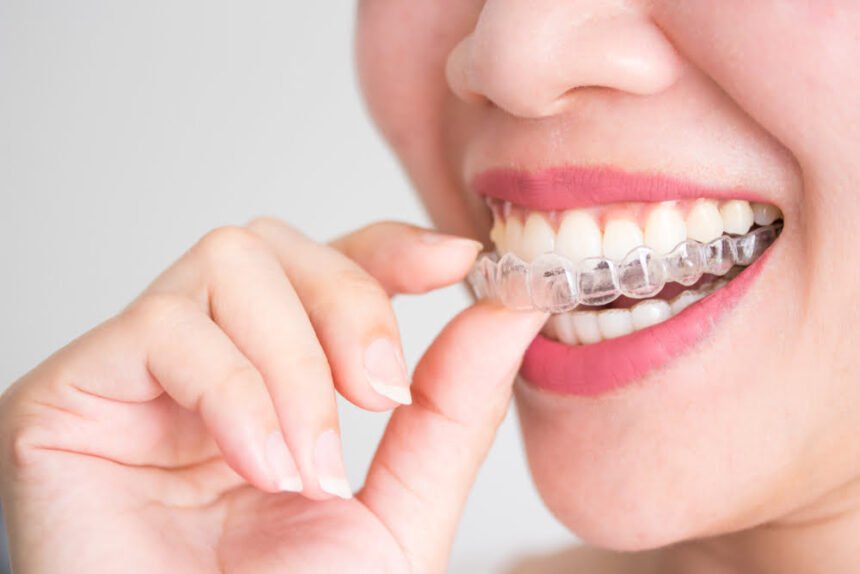Fixing a crooked smile can be a long and dreadful procedure for some patients. The first thing that comes to mind when considering a perfectly aligned set of teeth is metal braces.
Traditional orthodontic treatment has helped millions of people get their ideal smile. However, in this era of modernity and advancement, there is a viable alternative to traditional brackets and wires. Invisalign is rapidly becoming the preferred method to straighten teeth without anyone noticing that you are undergoing orthodontic treatment.
If you are excited about getting the perfect smile without a mouth full of metal by using Invisalign, one of the factors that might influence your decision is the cost.
The good news is that these clear braces are typically only slightly more expensive than traditional braces but have numerous benefits over them. However, they can be a more economical option for a short treatment time.
Read on to learn more about the average price of Invisalign treatment and some essential factors that determine the overall cost of treatment.
What is Invisalign?
Invisalign is an orthodontic treatment modality that corrects the position of your malposed teeth using a series of clear aligners over time. The practically invisible aligners are custom-made for each patient to suit their teeth requirements.
Invisalign treatment is non-invasive and virtually painless. Your dentist will take x-rays and 3D digital scans of the teeth using an advanced computer-aided-device computer-aided manufacturing (CAD-CAM) system. The system will help design customized aligners based on your jaw, teeth shape, and the extent of the deformity.
The method can aid in correcting a wide range of mild to severe dental problems, including spacing, crowding, open bite, underbite, crossbite, and misalignment.
How does it work?
Invisalign works by applying small amounts of controlled force on the teeth, gradually moving them into the new position. You will wear each set of aligners for about one to two weeks maximum and then move on to the next ones as the precise movement with the previous set of aligners has been achieved.
For timely and effective results, you must wear the aligners for the recommended time each day (20-22 hours a day). Usually, the treatment lasts six months to two years, which is still 67% quicker than traditional braces.
Cost of the treatment
The average cost of traditional metal braces ranges from $2,000 to $6,000. On the other hand, the average Invisalign treatment costs between $3,000 to $5,000. However, it varies between individuals.
Invisalign requires you to wear as many sets of aligners as it takes to get the desired results. The number of aligners varies according to personal condition, age, and extent of the deformity. Therefore, the cost can vary.
Mild cases that require 5 to 7 aligners will cost about $1,200 to $2,000, while mild-to-moderate cases needing 14-20 aligners will require you to pay $3,000 to $5,000.
Severe cases can skyrocket the price of the treatment up to $8,000.
The average cost of comprehensive Invisalign treatment for moderate cases is about $5,000.
Factors affecting the cost of treatment
Your treatment’s efficacy relies on your doctor’s expertise, and therefore, you should consciously select the ideal Invisalign orthodontist.
The cost of the treatment is dependent on several significant factors, including:
The severity of the condition
The complexity of the malocclusion determines the number of aligners you must wear during the treatment. You can achieve straightforward, minor movement of the teeth with fewer aligners, but severe cases require more aligners and appliances like bands, which will cost more.
Treatment duration
The duration of the treatment is also a determining factor for the cost. The longer the treatment period, the more you will have to pay.
Experience of the dentist
Invisalign is a relatively newer field of dentistry. Most orthodontists are accustomed to working in conventional ways (metal braces) with little experience in aligners.
The caliber of an orthodontist can mean a great deal in the long term, so you must ensure you approach the ideal dentist and not merely go for the most cost-efficient option. A highly skilled and experienced orthodontist specializing in Invisalign aligners is likely to cost more than a general dentist providing Invisalign as part of his practice.
Patient compliance
Compliance and consistency of the patient play a vital role in the timely completion of the treatment. Invisalign requires you to wear the aligners for at least 20-22 hours daily. If you do not wear it for the recommended time, progress will be slow, adding to the time and potentially the cost of the treatment.
Invisalign vs. traditional braces
There are numerous benefits of Invisalign in place of conventional braces. The best part about the treatment is that it is discreet, painless, and hassle-free. Some of the most significant benefits of traditional braces include the following:
- Removable while eating and drinking
- More comfortable without wires and brackets that can irritate your tongue or gums
- Almost invisible to the naked eye
- You can easily clean your teeth by removing the aligners, which can be tough with fixed braces
Wrap up
Invisalign is a comfortable and virtually invisible way to straighten teeth and achieve the smile of your dreams. This type of orthodontic treatment is gaining popularity, with an increasing number of orthodontists providing clear aligners as part of their dental services.
While Invisalign offers numerous advantages over metal braces in transforming your smile, the cost is one of the major factors to consider before proceeding with the treatment.
The average cost of Invisalign is about $5,000. However, this depends on multiple factors that can increase or decrease how much you have to pay for treatment, including the complexity of your case, compliance with wearing the aligners, and the orthodontist you choose.

